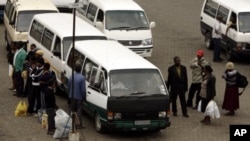In South Africa, minibus taxis are the most used and yet the most dangerous public transport. They account for double the rate of crashes than all other passenger vehicles.
It is rush hour for one of the busiest taxi stands in downtown Johannesburg. Hundreds of people zigzag through the lined-up minibus taxis. One passerby almost gets hit by a taxi as it suddenly pulls out of the parking area.
South Africans have a live-hate relationship with minubus taxis. Princess has been using them for over 20 years.
"I take taxis because to me, it's quick, and it’s cheaper than the bus," said Princess, who is among the 65 percent of South Africans who use minibus taxis every day.
The minibus taxis came into use in the 1980s, under the apartheid, to take black workers from their restricted home communities to work and back. But now it is the most available and affordable means of transportation in the country.
Despite its popularity, the minibuses have a disastrous reputation for dangerous and careless driving, posing hazards to not only all cars on the road - but the very passengers who support the taxi business.
Princess says in her experience the drivers either don’t care or don’t know any better.
"I'm scared sometimes, because of their driving," she said. "They don't respect traffic rules because sometimes when it’s red, the robot [traffic light], they pass. When you tell him to slow down, he swears at you, sometimes they take you out of the taxi."
But passengers are not the only ones aware of this longstanding problem. The Ministry of Transport, along with the alcohol company Brandhouse, has a countrywide safety awareness campaign to try to improve the situation.
Every year at this time, since 2004, taxi drivers are evaluated, and taught basic safety lessons.
In a parking lot in Soweto, Zunaid Katz is driving through the last test curve under the eyes of the instructor. He is about to finish his one-day training. He has been a taxi driver for seven years, and today, he says he has learned something new.
“I've learned a lot, you should always wear your safety belts," he said. "And you must always be cautious of your mirrors.”
In addition to road rules and driving skills, the training also covers anger management lessons, customer care, and business skills. At the end of the annual national campaign, the best taxi driver wins a new minibus.
But according to the chairman of the National Taxi Alliance Francis Masitsa, training the taxi drivers is not enough without policing continued bad driving.
"Reckless driving is our main challenge," said Masitsa. "However our efforts are undermined by the corruption that exists in the law enforcement agencies' officials."
Penalties for reckless driving - such as fines or license suspension - are rare.
And while the training has been has been going on for eight years, there is no mechanism to pull drivers who fail the evaluation off the road.
Everyday, 22 million people are transported in minibuses across South Africa. So the stakes are high to make it safer.
News
Infamous Johannesburg Minibus Taxi Drivers Get Trained to Behave




